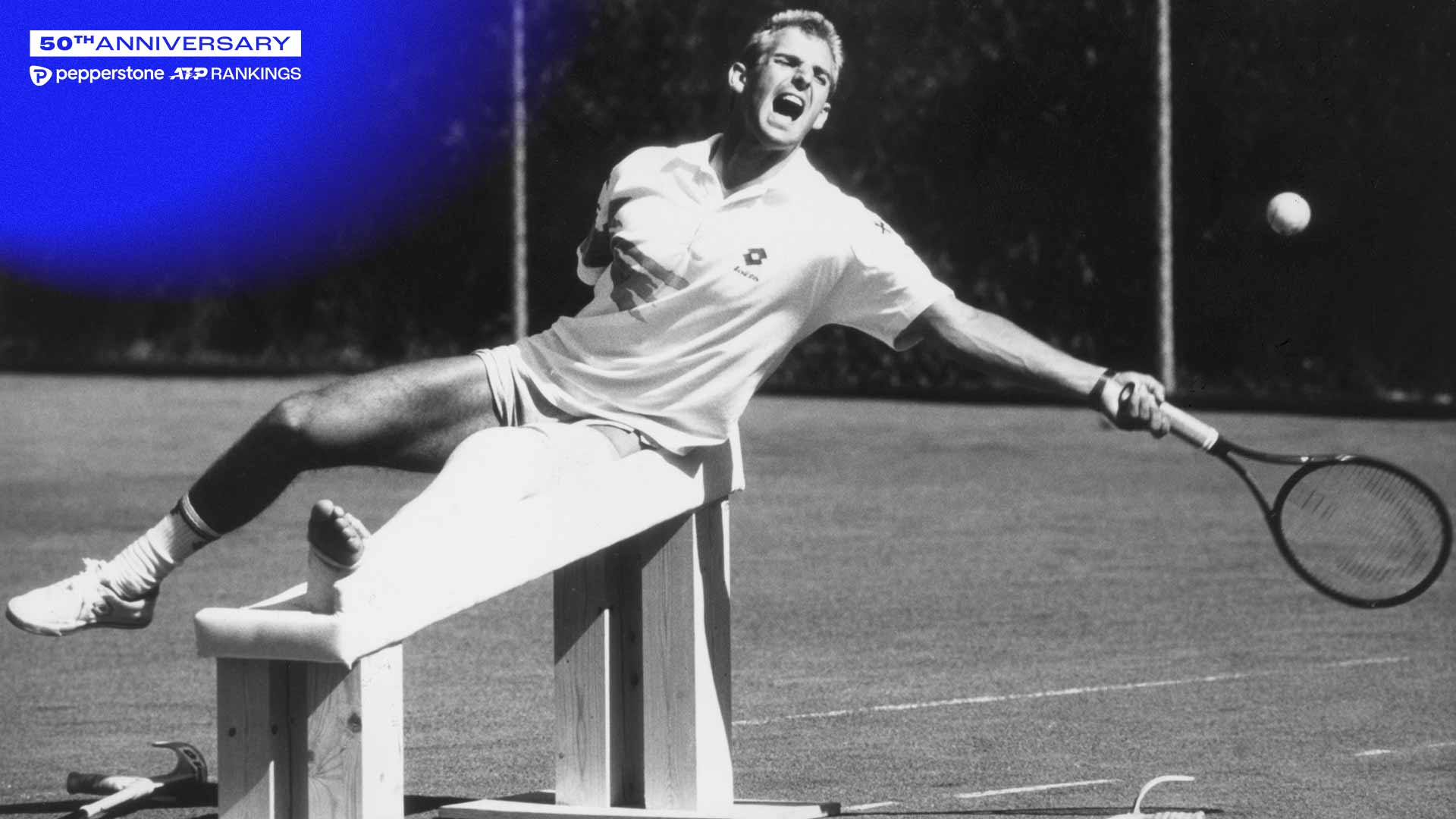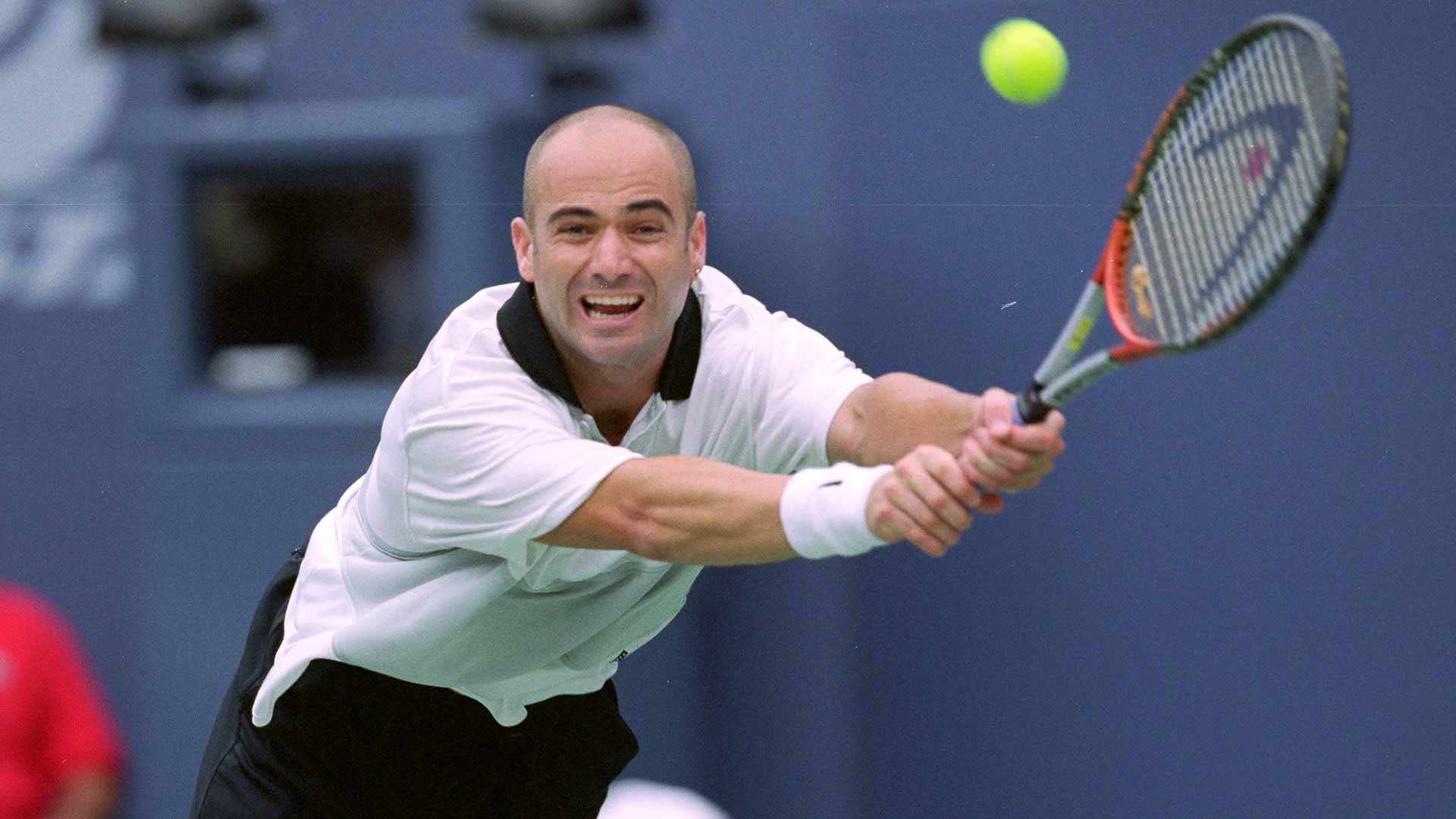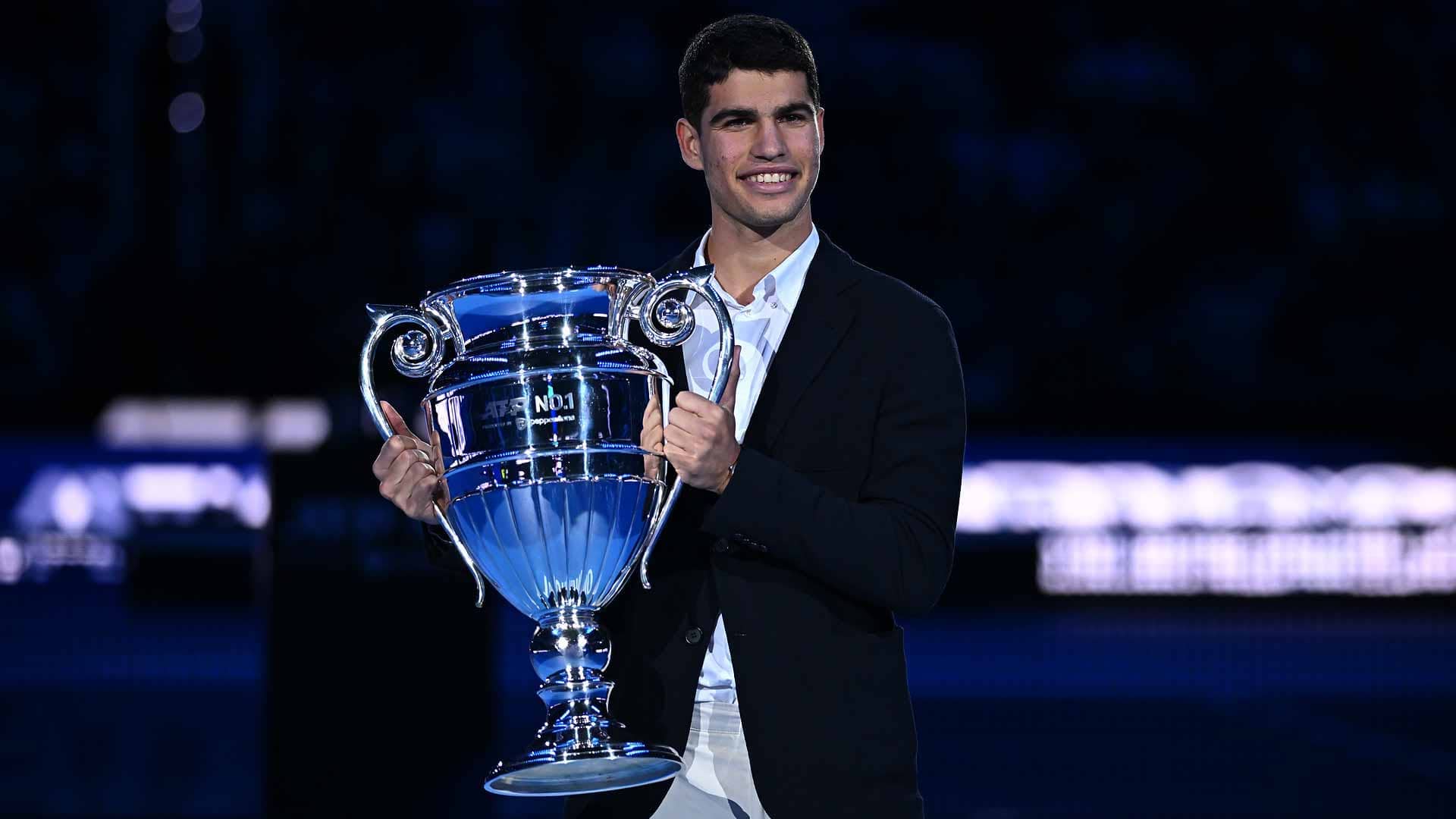

The road to World No. 1 is rarely straight forward. But some journeys have more twists and turns than others, especially those involving a slide from the mountain top before a character-building return to the summit.
To celebrate the 50th anniversary of the Pepperstone ATP Rankings this month, leading tennis writer and historian Joel Drucker reflects on five remarkable runs to the top.

Andre Agassi at the 1999 US Open. Photo Credit: Jamie Squire/Allsport
Andre Agassi had long been tennis’ biggest box office attraction. Yet in November 1997, he was competing at an ATP Challenger Tour event in his hometown of Las Vegas. World No. 1 just over two years prior, Agassi at this point was No. 141.
Agassi’s morale had been sapped by his loss to Pete Sampras in the 1995 US Open. Over the next two years, Agassi scarcely devoted himself to tennis. In 1997, he skipped the Australian Open, Roland Garros, and Wimbledon.
Matters bottomed out that autumn with a first-round loss in Stuttgart. Immediately came a long conversation with his coach, Brad Gilbert. As Agassi wrote in his autobiography, Open, “I say, OK, Brad, I’m not ready for it to be over. I’m all in. Tell me what to do, and I’ll do it.” Cue his return to the Challenger Tour.
"My fall from the top was in comparison to Bruce Springsteen playing at the local bar down the street," Agassi later said of his run to the final in Las Vegas. "People talk about me being humbled out there. Well for sure. I was fighting out there and I was very far from where I had been. But what more beautiful place to start the climb back than in your own backyard."
By early 1998, Agassi’s newfound dedication was clear, proven vividly by a February win over Sampras in the final of an ATP Tour event in San Jose, California. At year’s end, Agassi had soared back up to World No. 6. That, though, was mere prologue for what was to come.
In the spring of 1999, Agassi nursed a shoulder injury, but was convinced by Gilbert to play Roland Garros. Following several early-round struggles, he reached the final for the third time. Twice Agassi had been the favourite but was upset. This time was different. Agassi rallied from two sets to love down to beat Andrei Medvedev and complete the career Grand Slam of winning all four majors.
From there, it only got better: a final run at Wimbledon, winner at the US Open, the latter an impressive rally from two sets to one down versus Todd Martin. With that victory, Agassi returned to No. 1. He later wrote about that moment, “It’s the first time I’ve felt, or dared to say aloud, that I’m a grown-up.”

The date was 5 June, 2018. Novak Djokovic entered the interview room at Roland Garros. He had just lost in the quarter-finals to the No. 72-ranked Marco Cecchinato. This marked the fifth straight major where Djokovic had failed to reach the semis.
So demoralised was Djokovic that, when asked his plans for Wimbledon, he said: “I don’t know if I’m going to play on grass.” Given that these comments were made immediately after a painful loss, only a fool dared believe Djokovic would skip one of the world’s most prestigious tournaments.
Still, by the end of Roland Garros, Djokovic was World No. 22. It had been more than 11 years since he’d been outside the Top 20 (October 2006).
As we continue celebrating 50 years of Pepperstone ATP Rankings, we take a look back at some of the most impressive risers and comebacks through the years! 🤩
— ATP Tour (@atptour) August 7, 2023
@pepperstonefx | #ATPRankings | #50thAnniversary pic.twitter.com/lvDSvKP9mc
Seeded 12th at Wimbledon, Djokovic made his way to the semi-finals. Then, a masterpiece: victory over Rafael Nadal, a two-day classic that Djokovic won, 10-8 in the fifth. There followed a win versus Kevin Anderson in the championship match.
Djokovic’s renaissance continued at the US Open, capped off in the final when he defeated 2009 champion Juan Martin del Potro. On 5 November, after reaching the final at the Rolex Paris Masters, Djokovic returned to World No. 1.
Speaking the next week in London at the start of the Nitto ATP Finals, Djokovic said: “Five months ago, if you told me that... I always believe in myself, but it was highly improbable at that time considering my ranking and the way I played and felt on the court… I'll probably be able to speak more profoundly about it when the season is done and hopefully if I get to finish as No. 1.”
Despite a final loss to Alexander Zverev in London, Djokovic won his first four matches at the season finale in straight sets to ensure it was mission accomplished.

Once upon a time in the very recent past there was an ambitious young tennis player named Carlos Alcaraz. This charismatic Spaniard has emerged not merely as a star. He is a supernova, lighting up every court he plays on.
In 2021, Alcaraz turned 18 and generated several significant results. Most notably, a quarter-final run at the US Open, highlighted by a third-round, fifth-set tie-break victory over World No. 3 Stefanos Tsitsipas. That effort made Alcaraz the youngest man to reach a Grand Slam singles quarter-final in more than 30 years. World No. 141 at the start of 2021, Alcaraz finished the year at No. 32.
Call the first half of 2022 “Comet Carlos.” Alcaraz rapidly racked up one title after another – February on the clay of Rio de Janeiro, April on hard courts in Miami and the clay of Barcelona, May on clay in Madrid. The Madrid run was particularly impressive, as Alcaraz beat Rafael Nadal and Novak Djokovic en route to the title. Even more, Alcaraz won with everything fans crave – the widest possible range of shots, a passion for competition, and first-rate sportsmanship.
Then, in the city that never sleeps, Alcaraz lit up New York. Seeded fourth at the US Open, the 19-year-old took the title. It wasn’t easy. Three of his victories went five sets. Against Jannik Sinner in the quarter-finals, Alcaraz fought off a match point in a five-hour, 15-minute classic that ended at 2:50 a.m.
The final was more straightforward, Alcaraz beating Casper Ruud in four sets. With that victory, Alcaraz rose to World No. 1 – making him the youngest man in the history of the Pepperstone ATP Rankings to attain that spot. “Well, it's crazy for me," he said. "I never thought that I was going to achieve something like that at 19 years old. Everything came so fast.”

In February 2018, Roger Federer was 36 years old. The way the Swiss maestro had turned back the clock over the preceding 13 months might well comprise the most amazing period of his incredible career.
In January 2017, Federer arrived in Melbourne for the Australian Open. He’d been away from competition for six months, the result of a knee injury suffered at Wimbledon.
Federer was seeded 17th. It had been more than four years since he’d won a major. And how would the knee respond?
But Down Under, Federer found the old magic. Six victories brought him to the final. To raise the trophy once again, he would have to get past his most formidable opponent, Rafael Nadal, who at that point led their rivalry 23-11.
Already as complete a player as there had ever been, Federer had been driving his backhand throughout the tournament with more conviction than ever – both earlier and harder. The primary objective: defuse Nadal’s high-bouncing topspin cross-court lefty forehand. Down 1-3 in the fifth set of the final, Federer played brilliantly, winning five straight games to earn what was arguably the most satisfying of his 20 majors.
More great tennis followed. At Wimbledon, Federer won the championship without the loss of a set – the first man to do that in 41 years. In January 2018, a successful title defence in Melbourne.
So it was that on 19 February, 2018, Federer returned to the top spot he had last held more than five years earlier. "I think reaching No. 1 is the ultimate achievement in our sport,” he said. “This one maybe means the most to me [of any achievement] throughout my career, getting to No. 1 and enjoying it right here at 36, almost 37 years old. [It] is an absolute dream come true, I can’t believe it.”

Muster trains despite injury in 1989. Photo Credit: Exler/ullstein bild via Getty Images
Talent is a word often associated with the allegedly natural – elegant, effortless. Tennis’ avatar is Roger Federer. But as another legend, 39-time Grand Slam champion Billie Jean King, once said, “Persistence is a talent.”
And in tennis, no one more viscerally brought that concept to life than Thomas Muster.
Muster’s assets were punishing groundstrokes, unsurpassed fitness, and a competitive intensity worthy of his fellow left-handers, Jimmy Connors and Rafael Nadal.
As 1989 began, Muster had cracked the Top 20 and earned five tour-level singles titles – all on clay.
Eager to prove himself on all surfaces, Muster in January reached the semi-finals on the hard courts of the Australian Open. He followed that up in March with magnificent tennis in Miami. In the last four, Muster rallied from two sets to love down to beat Yannick Noah and earn the chance to play Ivan Lendl in the final of a tournament that was then informally known as tennis’ fifth Grand Slam.
The victory over Noah meant that Muster would crack the Top 10 for the first time. And with the clay-court season just around the corner, even greater possibilities were on the horizon.
Then, tragedy. Hours after the win over Noah, as Muster searched inside his car, he was hit by a drunken driver, in the process severing tendons in his left knee. There followed five months of rigorous rehab. An iconic video shows Muster in a wheelchair, leg raised, repeatedly hitting forehands.
Once recovered, Muster willed his way back up the ranks. His 1995 campaign was exceptionally productive. That year, he won 12 tournaments – including the one major of his career at Roland Garros.
Further payoff for persistence came on 12 February, 1996, when Muster rose to World No. 1 for the first time – nearly seven years after that night in Miami. “I don’t know how many people can say that, measurably, they have been No. 1 at something, the best in the world,” he said. “I loved that moment.”
Through tragedy and triumph, Muster had proven himself as one of tennis’ most brilliantly persistent competitors.